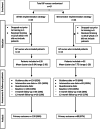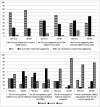Comparing a ses-sensitive and an all-ses implementation strategy to improve participation rates of patients with a lower socioeconomic background in a web-based intervention for depressive complaints: a cluster randomised trial in primary care
- PMID: 35948866
- PMCID: PMC9367024
- DOI: 10.1186/s12875-022-01793-w
Comparing a ses-sensitive and an all-ses implementation strategy to improve participation rates of patients with a lower socioeconomic background in a web-based intervention for depressive complaints: a cluster randomised trial in primary care
Abstract
Background: Depression is a major public health concern, which is most pronounced in population segments with a lower social-economic status (SES). E-health interventions for depressive complaints are proven to be effective, but their reach needs to be improved, especially among people with a lower socioeconomic status (SES). Implementing e-health interventions in the primary care setting with SES-sensitive guidance from General Practice nurses (GP nurses) may be a useful strategy to increase the reach of e-health in lower SES groups. We implemented an evidence-based online intervention that targets depressive complaints in primary care.
Methods: A pragmatic cluster-randomised trial was conducted in two parallel groups where a SES sensitive (SES-sens) implementation strategy with additional face-to-face guidance by GP nurses was compared to an all-SES implementation strategy. The primary outcome was the percentage of lower SES participants in either condition. Participation was defined as completing at least 1 face-to-face session and 2 online exercises. Participation rates were evaluated using logistic mixed modelling.
Results: In both conditions, the participation rates of lower SES participants were quite high, but were notably lower in the SES-sens implementation condition (44%) than in the all-SES implementation condition (58%). This unexpected outcome remained statistically significant even after adjusting for potential confounders between the conditions (Odds Ratio 0.43, 95%-CI 0.22 to 0.81). Less guidance was provided by the GP nurses in the SES-sens group, contrary to the implementation instructions.
Conclusions: From a public health point of view, it is good news that a substantial number of primary care patients with a lower SES level used the implemented e-health intervention. It is also positive that an all-SES implementation strategy performed well, and even outperformed a SES-sensitive strategy. However, this was an unexpected finding, warranting further research into tailoring implementation strategies of e-health interventions towards specific target groups in the primary care setting.
Trial registration: Netherlands Trial Register, identifier: NL6595 , registered on 12 November 2017.
Keywords: Depression; E-health; Implementation; Lower socio-economic status; Primary Care.
© 2022. The Author(s).
Conflict of interest statement
The authors declare that they have no competing interests.
Figures





Similar articles
-
Implementing complaint-directed mini-interventions for depressive complaints in primary care to increase participation among patients with a lower socioeconomic status: design of a cluster randomised controlled trial.Trials. 2020 Jan 10;21(1):64. doi: 10.1186/s13063-019-3890-6. Trials. 2020. PMID: 31924275 Free PMC article.
-
Complaint-Directed Mini-Interventions for Depressive Complaints: A Randomized Controlled Trial of Unguided Web-Based Self-Help Interventions.J Med Internet Res. 2017 Jan 4;19(1):e4. doi: 10.2196/jmir.6581. J Med Internet Res. 2017. PMID: 28052840 Free PMC article. Clinical Trial.
-
Effectiveness and cost-effectiveness of four different strategies for SARS-CoV-2 surveillance in the general population (CoV-Surv Study): a structured summary of a study protocol for a cluster-randomised, two-factorial controlled trial.Trials. 2021 Jan 8;22(1):39. doi: 10.1186/s13063-020-04982-z. Trials. 2021. PMID: 33419461 Free PMC article.
-
Rehabilitation Exercise and psycholoGical support After covid-19 InfectioN' (REGAIN): a structured summary of a study protocol for a randomised controlled trial.Trials. 2021 Jan 6;22(1):8. doi: 10.1186/s13063-020-04978-9. Trials. 2021. PMID: 33407804 Free PMC article.
-
Development and assessment of an active strategy for the implementation of a collaborative care approach for depression in primary care (the INDI·i project).BMC Health Serv Res. 2017 Dec 13;17(1):821. doi: 10.1186/s12913-017-2774-2. BMC Health Serv Res. 2017. PMID: 29237444 Free PMC article.
Cited by
-
Effect of a needs-based model of care on the characteristics of healthcare services in England: the i-THRIVE National Implementation Programme.Epidemiol Psychiatr Sci. 2025 Mar 26;34:e21. doi: 10.1017/S2045796025000101. Epidemiol Psychiatr Sci. 2025. PMID: 40135635 Free PMC article.
-
[Socioeconomic status and cecal adenocarcinoma mortality risk: an American population-based analysis].Nan Fang Yi Ke Da Xue Xue Bao. 2023 Aug 20;43(8):1417-1424. doi: 10.12122/j.issn.1673-4254.2023.08.20. Nan Fang Yi Ke Da Xue Xue Bao. 2023. PMID: 37712280 Free PMC article. Chinese.
References
-
- Li S, Gankpe FG, Wilner LB, Majeed A, Irvani SSN, Kravchenko MA, et al. Global, regional, and national incidence, prevalence, and years lived with disability for 354 diseases and injuries for 195 countries and territories, 1990–2017: a systematic analysis for the Global Burden of Disease Study 2017. Lancet. 2018;392:1789–1858. doi: 10.1016/S0140-6736(18)32667-9. - DOI - PMC - PubMed
-
- Karyotaki E, Riper H, Twisk J, Hoogendoorn A, Kleiboer A, Mira A, et al. Efficacy of Self-guided Internet-Based Cognitive Behavioral Therapy in the Treatment of Depressive Symptoms: A Meta-analysis of Individual Participant Data. JAMA Psychiat. 2017;74:351–359. doi: 10.1001/jamapsychiatry.2017.0044. - DOI - PubMed
Publication types
MeSH terms
LinkOut - more resources
Full Text Sources
